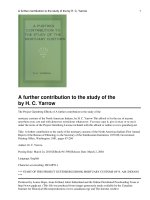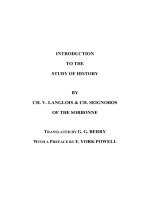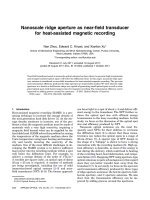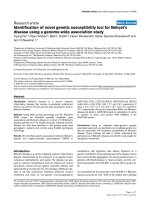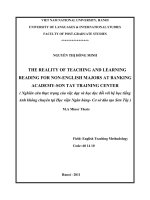THE STUDY OF NOVEL LIGHT DELIVERY SYSTEMS FOR HEAT ASSISTED MAGNETIC RECORDING
Bạn đang xem bản rút gọn của tài liệu. Xem và tải ngay bản đầy đủ của tài liệu tại đây (25.51 MB, 163 trang )
THE STUDY OF NOVEL LIGHT DELIVERY
SYSTEM FOR HEAT ASSISTED MAGNETIC
RECORDING
SAJID HUSSAIN
M.Sc., Electrical Engineering, NUS, Singapore
B.Sc., University of Engineering & Technology Lahore, Pakistan
A THESIS SUBMITTED FOR THE DEGREE OF DOCTOR OF
PHILOSOPHY
DEPARTMENT OF ELECTRICAL AND
COMPUTER ENGINEERING
NATONAL UNIVERSITY OF SINGAPORE
JANUARY 2015
DECLARATION
I hereby declare that the thesis is my original work and it has been written by
me in its entirety. I have duly acknowledged all the sources of information
which have been used in the thesis.
This thesis has also not been submitted for any degree in any university
previously.
Sajid Hussain
2015
i
Acknowledgements
I would like to express my deepest appreciation to my supervisor Dr. Aaron J.
Danner, who has the attitude and element of a genius. He continuously
conveyed an enthusiasm in regard to my experimental work. Without his
guidance and persistent help this dissertation would not have been possible.
I would like to thank my co-supervisors, Prof. Charanjit Singh Bhatia and Dr.
Hyunsoo Yang, who gave me great confidence by showing strong trust and
faith in me. They have always encouraged me to work harder and smarter and
provided me full freedom to explore my research work while focusing on the
final goal. I am grateful for them for allowing me to access and use the most
advanced fabrication and characterization techniques available in NUS,
without which it would not have been possible to complete my experimental
and characterization work for this thesis.
I would like to express my gratitude to all the past and present members in the
Spin and Energy Laboratory (SEL) of the National University of Singapore for
their appreciated help and friendship. Special thanks go to Dr. Deng Jun and
Mr. Siew Shawn Yohanes for their help in wafer dicing, thesis editing, FIB,
metal deposition and programming. I would also like to thank them for
sacrificing their valuable time to accompany me in the cleanroom whenever
required. It has been a real joy working with them, chatting with them and
having meals together.
I would like to thank all my friends in Singapore, especially Mr. and Mrs.
Ehsan Younis, Muhammad Hafeez, Fraz Ahmed, Yasir Cheema and Wakil
Shehzad for their guidance, help and encouragement. A special thanks to my
ii
best friend Ms. Nurjiha, for always being with me during all the ups and
downs. I owe these people a lot for everything they did for me during all these
years.
Lastly, I would like to thank my great parents and brothers who always gave
me their support, no matter what. I would like to take this opportunity to tell
you all that I love you all so much and I will always be in debt to everything
you have done for me in my life.
This work was supported by the Singapore National Research Foundation
under the 10 Tb/in
2
density storage project under CRP Award No. NRF-CRP
4-2008-06. Thanks are due to the academic and research staff at the
Department of Electrical and Computer Engineering, Spin and Energy Lab
(SEL) and Centre for Optoelectronics (COE).
iii
Abstract
The demand for magnetic storage density increases tremendously every year.
This drives the development of new techniques to increase the storage
capacity in hard drives. This development is impeded by the thermal limit of
magnetic media, also known as the superparamagnetic limit. This effect causes
small bits to change their magnetic orientation randomly, leading to data loss.
High coercivity magnetic media are required in order to overcome the
superparamagnetic effect. However, this requires a higher write head magnetic
field to obtain magnetic reversal of the magnetic bits.
Heat assisted magnetic recording (HAMR) is a next generation technology
proposed for achieving magnetic storage densities beyond 1 Tb/in
2
. The
principle of HAMR is similar to the derivative of magneto-optical recording
proposed by Katayama and Saga separately in 1999 [1, 2] and was first
demonstrated by Seagate in 2006 [3]. HAMR makes writing high anisotropy
media possible, facilitating the use of smaller thermally stable grains. In a
typical HAMR process, the temperature of a high anisotropy medium is raised
above its Curie temperature, lowering its coercivity to a value within the
writable range of a magnetic field supplied by a conventional write head.
However, the commercialization of HAMR faces substantial technical
challenges that must be resolved before widespread adoption of the technology
can commence. Foremost of these challenges is the development of a precise
method of delivering light to a very small, sub-wavelength bit area with
sufficient power to heat a high coercivity magnetic medium above its Curie
temperature. Complex fabrication processes, low power transfer efficiency and
iv
high heat dissipation are the biggest problems faced in current HAMR light
delivery systems.
In this thesis a new light delivery system consisting of the nano-aperture
vertical-cavity surface emitting laser (VCSEL) as a potential candidate for an
alternative light delivery system in HAMR is proposed. The transmission and
focusing characteristics of differently shaped nano-apertures, including the
conventional square shape and unconventional shapes such as the C-shape, H-
shape, T-shape and L-shape are studied via simulation, in order to find the
most suitable shape to be used as a near field transducer for HAMR
applications. The C-shaped nano-aperture shows the best transmission and
focusing characteristics and is the strongest candidate as a near field
transducer (NFT) for HAMR. The resonant wavelength of C-shaped nano-
apertures is strongly affected by the storage media, placed in the near-field of
the nano-aperture.
The power density requirement has been found with successful HAMR
demonstrations with control C-shaped nano-aperture near-field transducers
fabricated on glass substrates. The C-apertures have shown localized focusing
properties compared to square aperture which have low power transmission
and cannot be used for successful HAMR demonstration, with the same
incident power density as the C-apertures.
850-nm VCSELs with large arrays of differently shaped nano-apertures in the
Au layer on the top facets were fabricated and statistical methods were used to
obtain reliable indicators of performance of each aperture. The power density
available from C-shaped nano-aperture VCSELs is comparable to the power
v
density required for HAMR, which makes these VCSELs a strong alternative
light delivery system for HAMR, with additional advantages of easy
fabrication, low cost and less thermal losses inside the system.
vi
Table of Contents
Acknowledgements i
Abstract iii
Table of Contents vi
List of Figures xi
List of Tables xviii
List of Symbols and Abbreviations xix
List of Publications, Patents and Conferences xxiv
Chapter 1
Introduction 1
1.1. Fundamentals of Magnetism 1
1.2. Types of Magnetic Materials 3
1.3. History of Magnetic Recording 7
1.4. Conventional Recording Schemes 10
1.4.1. Longitudinal Magnetic Recording (LMR) 10
1.5. Superparamagnetism and Magnetic Trilemma 11
1.6. Advanced Recording Schemes 13
1.6.1. Perpendicular Magnetic Recording (PMR) 13
1.6.2. Exchange Coupled Composite Media (ECC) 15
1.6.3. Bit Patterned Media (BPM) 16
1.6.4. Microwave-Assisted Magnetic Recording 17
vii
1.7. Heat-Assisted Magnetic Recording 18
1.7.1. The HAMR Recording Process 20
1.7.2. HAMR Media 21
1.7.3. HAMR Optics and Head 22
1.7.4. Near-Field Transducers 23
1.8. Conventional HAMR Head 25
1.8.1. Previous Work 26
1.9. Obstacles in HAMR 28
1.9.1. Thermal Loading of Slider 28
1.9.2. Optical Path Integration 29
1.9.3. Sub-Diffraction Limited Optical Spots 29
1.9.4. The NFT Failure 30
1.9.5. HAMR Testing 30
1.10. Direct Light Delivery System 30
1.11. Possibilities and Challenges 31
1.12. Outline of Thesis 32
Chapter 2
Experimental Techniques 34
2.1. Patterning Techniques 34
2.1.1. Electron Beam Lithography (EBL) 34
2.2. Characterization Methods 36
viii
2.2.1. Scanning Electron Microscopy (SEM) 36
2.2.2. Vibrating Sample Magnetometer (VSM) 37
2.2.3. Magnetic Force Microscopy (MFM) 39
2.2.4. Magneto-Optical Kerr Effect Microscopy (MOKE) 40
2.3. Summary and Conclusions 42
Chapter 3
Near Field Transducer for HAMR 43
3.1. An NFT Figure of Merit 43
3.2. NFT Design Principles 45
3.3. Near Field Transducer and Surface Plasmons 46
3.4. Introduction to Finite Difference Time Domain simulations (FDTD) 50
3.5. Simulation Setup 51
3.6. Simulations of Differently Shaped Nano-apertures 53
3.7. Plasmonic Enhancement Through C-aperture 59
3.8. Summary and Conclusions 61
Chapter 4
Effect of Magnetic Medium on NFT Performance 63
4.1. Absorption Characteristics of FePt 63
4.2. Effect of FePt on The Transmission Characteristic of The NFT 66
4.3. Fly Height Effect 67
4.4. Effect on Resonant Transmission of The NFT 69
ix
4.4.1. FDTD Simulations 69
4.4.2. Sample Fabrication 71
4.4.3. Measurement Setup and Results 73
4.5. Summary and Conclusions 78
Chapter 5
Heat Assisted Magnetic Recording Analysis 80
5.1. Optical Characteristics of Thin Film FePt 80
5.2. Magnetic Storage Stack 82
5.3. Curie Temperature Measurements 83
5.4. HAMR Experimental Setup and Methodology 85
5.4.1. Pump-Probe Optical Setup 86
5.4.2. Temperature Dependent Change in Coercivity of The 89
Magnetic Medium 89
5.4.3. Effect of Polarization Orientation 91
5.5. HAMR using High Coercivity Medium 93
5.6. HAMR Through Apertures 95
5.6.1. HAMR using C-apertures 97
5.7. Summary and Conclusions 101
Chapter 6
Nano-aperture Vertical Cavity Surface Emitting Lasers (VCSELs) 103
6.1. VCSEL Introduction 104
x
6.2. Fabrication of VCSELs 107
6.3. Measurement Setup 112
6.4. Nano-aperture VCSELs 114
6.5. Fabrication of Differently Shaped Nano-aperture VCSELs 116
6.6. Summary and Conclusions 122
Chapter 7
Summary and Conclusions 123
7.1. Summary 123
7.2. Future Work 126
7.2.1. Optimization of Output Power from Nano-aperture VCSELs 127
7.2.2. Integration of VCSEL with Magnetic Write-Head 128
xi
List of Figures
Figure 1.1: (a) A magnetic dipole produced from an orbiting electron (b) spin
magnetic moment 2
Figure 1.2: (a) A solenoid with free space as medium, the magnetic field is B
O,
(b) magnetization developed when a material medium is inserted into the
solenoid 3
Figure 1.2: (a) A solenoid with free space as medium, the magnetic field is B
O,
(b) magnetization developed when a material medium is inserted into the
solenoid 4
Figure 1.3: An example of a hysteresis loop of a ferromagnetic material 6
Figure 1.4: Areal density growth trend [10]. Used with permission. 10
Figure 1.5: Schematic of LMR [9]. Used with permission. 11
Figure 1.6: Illustration of magnetic recording trilemma 12
Figure 1.7: Schematic of PMR 14
Figure 1.8: ECC media grain, with hard and soft magnetic regions 16
Figure 1.9: (a) Conventional media and (b) BPM 17
Figure 1.10: Microwave-assisted magnetic recording using a high frequency
microwave signal 18
Figure 1.11: (a) Schematic diagram of HAMR (b) HAMR recording principle
19
Figure 1.12: Media stack for HAMR recording 21
Figure 1.13: Different nano-aperture designs for NFT: (a) Circular aperture,
(b) C aperture, (c) H aperture, (d) Bowtie aperture, (e) L aperture, and 24
Figure 1.14: A conventional HAMR system [71]. Used with permission. 25
xii
Figure 1.15: HAMR device structure, developed by Seagate Technology,
showing (a) the lollipop antenna, (b) PSIM and coupling antenna, and (c) a
summarized HAMR system [72]. Used with permission. 27
Figure 1.16: HAMR device developed by HGST: (a) HAMR structures, and
(b) simulation results for the E-antenna. The scale bar is 200 nm [73]. Used
with permission. 28
Figure 1.17: Schematic diagram of the direct light delivery system using a
nano-aperture VCSEL. The light from the VCSEL is focused on the magnetic
medium through a nano-aperture. 31
Figure 1.18: Side view of a nano-aperture VCSEL (with emission facet at the
top, opposite to that shown in Figure 1.17). The output power changes
quadrically as the diameter of the aperture is changed. 32
Figure 2.1: A normal EBL process using positive resist 36
Figure 2.2: Schematic of a VSM; sample holder and detection mechanism 38
Figure 2.3: Magnetic force microscopy setup, showing the tapping needle and
the detection laser 39
Figure 2.4: Schematic of a Kerr microscope with all the optical components 41
Figure 3.1: An electromagnetic wave travelling along the interface. It can be
viewed as (a) a time-dependent surface charge distribution and, (b)
propagating electromagnetic wave. Adapted from [86, 87]. 49
Figure 3.2: The Yee Cell and the field locations. Adapted from [89]. 51
Figure 3.3: Layout of the simulation setup 52
Figure 3.4: Transmission of a plane wave through a nano-aperture 54
Figure 3.5: Schematic of the simulation setup 54
xiii
Figure 3.6: (a) the square aperture geometry (b) the near-field intensity
distribution through the square aperture (simulated) 55
Figure 3.7: Schematic structure of the nano-apertures. a) C-aperture; b) I-
aperture; c) T-aperture; d) L-aperture; e) Bowtie aperture 56
Figure 3.8: Simulated near-field intensity distribution 10 nm away; a) from the
C- aperture; b) from the H-aperture; c) from the T-aperture; d) from the L-
aperture; e) from the bowtie aperture; e) from the square aperture. The
incident light is polarized in X direction. 57
Figure 3.9: Schematic diagram showing a C-aperture with a Au NP in the
center, (a) the top view and, (b) cross-sectional view 60
Figure 3.10: Simulated near-field intensity from a C-shaped nano-aperture is
enhanced as a function of diameter of a NP placed inside the C-aperture.
Intensity enhancement is maximum for a NP with a diameter of 60 nm (a).
Similarly the optical spot produced by C-aperture varies as the dimater of the
NP is varied, shown in (b) 60
Figure 4.1: Schematic of the optical setup used to measure the absorption of a
magnetic medium 64
Figure 4.2: Polarization dependent characterization of FePt. Different
polarization orientations show the same optical characteristics (experimental).
65
Figure 4.3: (a) Schematic of the simulation setup, and (b) geometry of the C-
aperture 66
Figure 4.4: Effect of fly height on (a) optical spot size and (b) normalized
near-field peak intensity (simulated) 68
xiv
Figure 4.5: Simulated transmission spectra of a C-aperture for four different
FePt thicknesses 70
Figure 4.6: Fabrication process for the sample used in these measurements.
The process includes steps such as deposition, resist coating, lithography and
dry etching 74
Figure 4.7: SEM image of the fabricated C-shaped nano-apertures 74
Figure 4.8: The experimental setup including: (a) the free-space optical setup
used to measure the transmission spectra (b) different measurement
configurations to include and exclude effect of the media 75
Figure 4.9: Measured transmission spectra through C-apertures for different
FePt thicknesses. A significant shift in the resonant wavelength can be seen
which validates the simulation results. 76
Figure 4.10: Plot of the near-
(simulated) 77
Figure 5.1: Transmission characteristics of FePt thin film, deposited on a glass
substrate. (a) Transmission spectra and, (b) reflection spectra 81
Figure 5.2: The magnetic media structure, showing all the underlayers 82
Figure 5.3: (a) Temperature dependent B-H loops of FePt and (b) is a
magnified view of the central region of (a) 84
Figure 5.4: Coercivity reduction with increasing temperature 85
Figure 5.5: The pump-probe optical setup used to measure the irradiance
dependent B-H loops of FePt 87
Figure 5.6: Pump-probe setup 88
Figure 5.7: B-H loops of FePt and commercial media sample using pump-
probe optical setup 89
xv
Figure 5.8: The alignment of the pump and probe lasers. 89
Figure 5.9: The dependence of B-H loops of FePt on the incident laser power
90
Figure 5.10: The curve shows the reduction of the FePt coercivity with the
incident power density 91
Figure 5.11: Dependence of coercivity of the media on laser power having
different polarization orientations. 92
Figure 5.12: The optical setup used for HAMR demonstration 94
Figure 5.13: (a) A Kerr-microscopic image showing the area illuminated by
the HAMR laser. The domains in the black lines have a magnetic orientation
opposite to that of the other areas on the sample (b) MFM image of the same
lines 94
Figure 5.14: The experimental setup for HAMR through apertures. 95
Figure 5.15: Magnetic bits achieved using square apertures of different size
using HAMR. (a) Kerr microscopic and (b) MFM images of the magnetic bits
achieved. 96
Figure 5.16: C-aperture and square aperture used for HAMR demonstration . 97
Figure 5.17: Mask design showing alternating arrays of square and C-
apertures 98
Figure 5.18: Kerr microscopic image shown the magnetic reversal obtained by
C-apertures 99
Figure 5.19: MFM image shows the magnetic spot produced by the C-
apertures 100
xvi
Figure 5.20: Different sized bits can be achieved using C-apertures with
different aperture sizes. Magnetic bits achieved by two differently sized C-
apertures can be seen by (a) Kerr microscopic image, and (b) MFM image . 100
Figure 6.1: Structure of a conventional oxide aperture VCSEL 106
Figure 6.2: SEM image of an etched mesa in a VCSEL epitaxial wafer. It can
be seen that the etching was stopped exactly at the top of the bottom DBR . 109
Figure 6.3: The wet oxidation setup showing the furnace, the water bubbler,
and the N
2
inlet 110
Figure 6.4: Fabrication process of a nano-aperture VCSEL, showing all the
steps 111
Figure 6.5: Microscopic images of (a) a fabricated VCSEL, and (b) a lasing
VCSEL 112
Figure 6.6: The measurement setup used to characterize VCSELs. The probes
are used to inject the current into the VCSELs and the photo-detector is used
to measure the output power of the VCSELs 112
Figure 6.7: A set of PI curves obtained from various VCSELs fabricated on
the same wafer 113
Figure 6.8: Schematic of a nano-aperture VCSEL based on a conventional
VCSEL 114
Figure 6.9: Fabrication of nano-aperture VCSELs; (a) Au deposition, (b) nano-
aperture formation 117
Figure 6.10: SEM images of differently shaped nano-apertures: (a) C-aperture,
(b) I-aperture, (c) L-aperture and (d) T-aperture 118
Figure 6.11: (a) Microscopic and (b) SEM image of a fully fabricated nano-
aperture VCSEL 119
xvii
Figure 6.12: The far-field power measured from differently shaped nano-
aperture VCSELs 120
Figure 6.13: Far-field power measured from C-aperture VCSEL 121
Figure 7.1: Schematic structure of a nano-aperture VCSEL 127
Figure 7.2: Schematic showing integration of the write head and nano-aperture
VCSEL. (a) Side view, (b) top view, and (c) 3D view 129
xviii
List of Tables
Table 3.1: Properties of the materials used in simulation setup 54
Table 3.2: Transmission and focusing characteristics of differently shaped
nano-apertures. The incident light is polarized in X direction. 58
Table 3.3: The summary of transmission characteristics of a C-aperture with
using multiple NPs 61
Table 4.1: Properties of the media stack 67
Table 5.1: Description of the components used in the pump-probe setup 86
Table 6.1: Power densities available for different sizes of active apertures 116
Table 6.2: Comparison of nano-aperture VCSELs using differently shaped
nano-apertures 120
xix
List of Symbols and Abbreviations
Demagnetization field
Local field intensity.
Magnetic flux density
Exchange interaction
Magnetic field strength
Total angular momentum
Current density at a location
Exchange constant
Magnetization
Coercivity squareness
Threshold current
Electron plasma frequency
µ
0
Permeability of the magnetic material
Å
Angstroms
ABC
Absorbing boundary conditions
AFC
Anti-ferromagnetically coupled
AFM
Atomic force microscopy
BPM
Bit patterned magnetic media
CW
Continuous-wave
CCD
Charged-coupled device
xx
cm
Centimeters
D
Dose (charge per unit area)
DBR
Distributed Bragg Reflector
DUT
Device under test
EAMR
Energy assisted magnetic recording
EBL
Electron beam lithography
ECC
Exchange coupled composite media
FDTD
Finite Difference Time Domain
FePt
Iron platinum
FE-SEM
Field emission-scanning electron
microscopy
FM
Ferromagnetic
FWHM
Full width at half maximum
Gb
Gigabyte
h
H
c
Coercive field
HAMR
Heat assisted magnetic recording
HCP
Close-packed structure
HDD
Hard disk drive
HSQ
Hydrogen silsesquioxane
in
Inch
I.E.
Intensity enhancement
IPA
Isopropyl alcohol
Kb
Kilobyte
k
B
Boltzmann constant
xxi
kOe
Kilo-Oersteds
K
u
Magnetocrystalline anisotropy constant
Orbital angular momentum
LCP
Left handed circular polarization
LED
Light emitting diode
LMR
Longitudinal magnetic recording
LP
Linear polarization
Magnetic moment
MAMR
Microwave assisted magnetic recording
Mb
Megabyte
MFM
Magnetic force microscopy
MIBK
Methyl isobutyl ketone
MOKE
Magneto-optical Kerr effect microscopy
M
r
Remanent magnetization
M
s
Saturation magnetization
mW
Milliwatts
Demagnetization tensor
NA
Numerical aperture
NFT
Near field transducer
NIL
Nanoimprint lithography
nm
Nanometers
NP
Nano-particle
Oe
Oersted
OC
Overcoat
PMMA
Polymethyl methacrylate
xxii
PML
Perfectly matched layer
PMR
Perpendicular magnetic recording
PSTM
Photon Scanning Tunneling Microscope
PSIM
Planar solid immersion mirror
QWs
Quantum wells
RAMAC
Random access method of accounting
RCP
Right handed circular polarization
Spin angular momentum
COE
Center for optoelectronics
SEL
Spin and energy lab
SEM
Scanning electron microscopy
SIL
Solid immersion lens
SIM
Solid immersion mirror
SNR
Signal to noise ratio
SPs
Surface Plasmons
SUL
Soft underlayer
T
Temperature in Kelvin
Tb
Terabyte
T
C
Curie temperature
UHV
Ultra-high vacuum
V
Volume
VCSEL
Vertical Cavity Surface Emitting Laser
VSM
Vibrating sample magnetometer
Micrometer
µ
B
Bohr magnetrons
xxiii
Microwatt
Electron velocity
Wave vector
Momentum of each photon
Quantum efficiency

